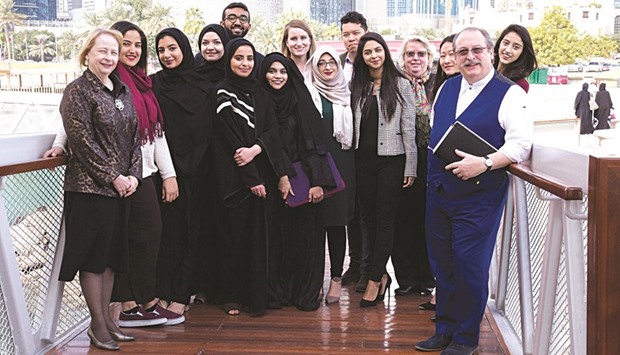The significance of Qatar’s architectural heritage was outlined by Qatar Green Building Council (QGBC) specialists, Dr Alex Amato and Dr. Cynthia Skelhorn at a series of lectures for students at Northwestern University in Qatar (NU-Q).
The presentations were part of an NU-Q course entitled ‘Advanced Online Storytelling’. Delivered by industry experts drawn from QF Capital Projects, Qatar University, and Makower Architects, among others, the lectures provided students with an insightful and informed perspective of Doha’s recent rapid growth and its resulting architectural townscape.
Valuable skills were also demonstrated, such as the use of Geographic Information Systems (GIS) in mapping Qatar’s architectural heritage.
Dr Amato, head of Sustainability at QGBC, said: “While Doha’s traditional architecture is important to this story, the city’s rapid urbanisation since the onset of petrochemical wealth has resulted in the formation of many new neighbourhoods that contain architecturally notable buildings that need to be acknowledged for their worth.”
Additionally, as part of the five-week course, NU-Q launched a website documenting the evolution of Qatar’s architecture and urban development.
While appreciating the important work NU-Q’s students have carried out, Dr Amato observed that Doha’s buildings should be acknowledged for their genuine architectural value as the city is becoming an engaging architectural hub for both experts and tourists alike.
“We hope this is just the start, as there is still much that needs to be done, not only in terms of celebrating and recording, but also in terms of conservation, as some ‘architectural gems’ are either neglected or endangered by redevelopment.”
Dr Cynthia Skelhorn, research specialist at QGBC, said: “Doha has a considerable stock of traditional architecture that needs consistent effort to preserve and retrofit. One element of preservation is to document the exact locations of architecture that are particularly iconic, noteworthy, or representative of a particular era in Qatar’s development. To this end, students were introduced to online story-maps as an effective technology for visualising Doha’s architectural sites. We plan to continue recording these sites following the completion of the course.”
Christina Paschyn, Assistant Professor of Journalism at NU-Q, mentored the students and oversaw the production of the website. “My students and I appreciate QGBC’s valuable contribution. We hope that through the website, local and international communities will learn more about why Doha, from its skyline to its traditional houses, looks the way it does,” she said.
QGBC, a member of Qatar Foundation for Education, Science and Community Development (QF), advocates for best-practice sustainability and green buildings in Qatar, including cultural sustainability. The NU-Q website can be accessed at: http://sites.northwestern.edu/buildingdoha/

QGBC experts with NU-Q students at an event at Msheireb Enrichment Centre on Doha Corniche.
